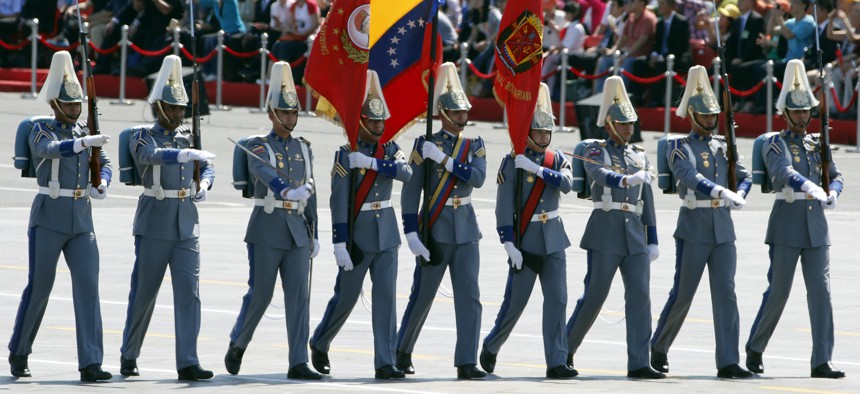
A Venezuelan military contingent took part in a parade in Beijing in 2015 commemorating the 70th anniversary of Japan's surrender during World War II. Ng Han Guan/AP
Beijing Has Started Giving Latin American Generals ‘Lavish,’ All-Expenses-Paid Trips to China
Inspired by the U.S.’s own programs to train and befriend foreign officers at American military institutions, Beijing is wooing the militaries of the U.S.’s neighbors.
China has started to woo America’s nearest allies by funding “lavish” trips for Latin American military officers to live and study across the Pacific. Beijing is courting officers from the region, offering to cover the cost of military education and travel, Adm. Kurt Tidd, the commander of U.S. Southern Command, told lawmakers Thursday.
“They are very lavishly funding to bring senior military officers from a variety of key countries around our region to China for very lavishly expensed, all-expense-paid trips for them, for their families to be able to live very high lifestyles in the country,” Tidd said at a Senate Armed Services Committee hearing.
Beijing was inspired by the U.S.’s own longstanding similar effort: the International Military and Education & Training, or IMET, program. That program has brought young foreign military officers to the States to take classes at U.S. military facilities since 1976. It’s not without its flaws, but U.S. commanders say it’s a critical tool that not only builds professional militaries in partner nations and increases interoperability, but facilitates lifelong relationships that can be leveraged in peacetime or in the midst of a crisis.
“I’ve long felt that the IMET program is probably our single greatest long-term investment value for the dollar that we put into it,” Tidd said. “It is an investment that sometimes may take two decades or more to pay off, but when it pays off, it pays off with relationships with strategic partners that are absolutely critical.”
IMET is funded through the State Department, which would see a 23 percent cut in its funding if President Donald Trump’s 2019 budget proposal were enacted. But members of Congress on both sides of the aisle recognize the program’s success:
“I know in Africa, the IMET program is singularly one of the truly great programs we have,” said Sen. Jim Inhofe, R-Okla., who chaired the hearing in Arizona Republican Sen. John McCain’s absence. “Once we get them in with us, they’re there for life, and we see evidence of this all the time.”
As does, China, Tidd said.
“China watches that very closely,” he said. “They’ve recognized the value of that strategic investment and they basically have taken a leaf out of our book.”
Yet even as China starts to cultivate military ties and develop an international military footprint, most of its engagement with the world is economic. That’s true in the western hemisphere too: from a (stalled) $50-billion canal project in Nicaragua to investments in the Caribbean.
“The larger strategic challenge posed by China in this region is not yet a military one,” Tidd said in his prepared remarks. “It is an economic one, and a new approach may be required to compete effectively against China’s coordinated efforts in the Americas. Some of the most critical elements needed in this effort are not ones that USSOUTHCOM can bring to bear.”
Combating the Opioid Epidemic
Tidd, whose geographic command stretches from Mexico’s southern border through all of South America, was also asked repeatedly about the opioid epidemic America is facing. Thus far it has cost the U.S. economy $1 trillion, and killed more than 115 Americans daily in 2016, the most recent year for which data is available. Nearly all of the heroin used in the U.S. enters the country through Mexico, according to the State Department’s assistant secretary responsible for international narcotic law enforcement. Most prescription opioids on the black market are sourced domestically, and fentanyl is produced in China.
Tidd said he has “pretty good situational awareness” of most of the narcotics trafficking through Latin America and the Caribbean but is only able to interdict about 25 percent of them. The Coast Guard helps, but a few targeted military investments could help get at the rest.
“I think there’s some platforms out there that would be enormously helpful to us,” he said. “[The] littoral combat ship would fit perfectly into the mission space … It’s a package, it’s a vessel that’s capable of operating in the eastern Pacific with rotary wing, with interceptor boats as a package, coupled with maritime patrol aircraft.”





